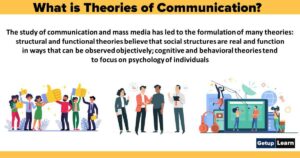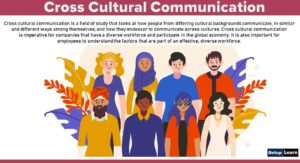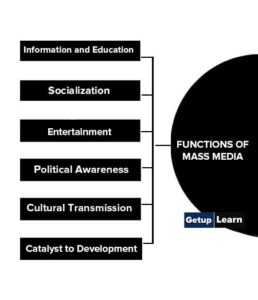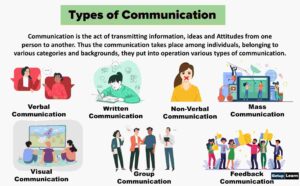Table of Contents
What is Verbal Communication?
Verbal communication is defined as communication to express our views, information, and ideas in the form of sound and words. The spoken part usually involves face-to-face communication. and when people ponder the word communication, they often think about the act of talking.
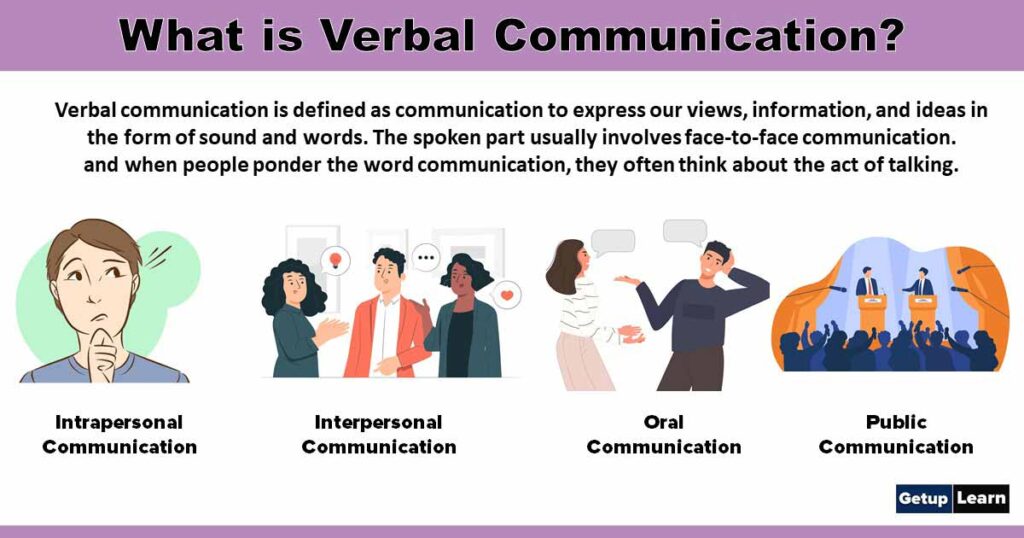
Table of Contents
We rely on verbal communication to exchange messages with one another and develop as individuals. The term verbal communication often evokes the idea of spoken communication, but written communication is also part of verbal communication.
In other words, t is defined as the exchange of information with the use of words, either spoken or written.
Advantages and Disadvantages of Verbal Communication
Let’s discussed the advantages and disadvantages of verbal communication:
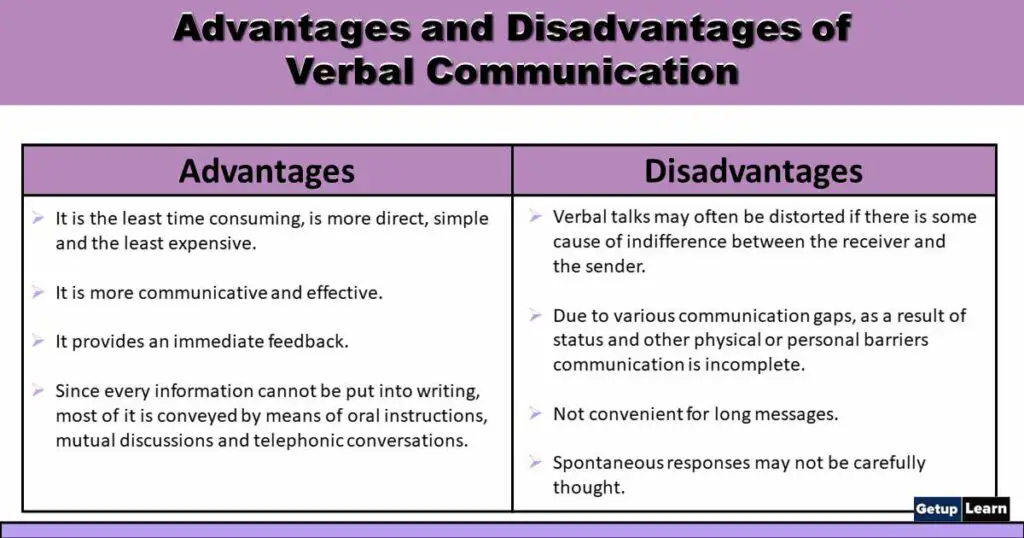
Advantages of Verbal Communication
Following are the advantages of verbal communication:
- It is the least time-consuming, is more direct, simple, and the least expensive.
- It is more communicative and effective.
- It provides immediate feedback.
- Since every piece of information cannot be put into writing, most of it is conveyed by means of oral instructions, mutual discussions, and telephonic conversations.
Disadvantages of Verbal Communication
Following are the disadvantages of verbal communication:
- Verbal talks may often be distorted if there is some cause of indifference between the receiver and the sender.
- Due to various communication gaps, as a result of status and other physical or personal barriers communication is incomplete.
- Not convenient for long messages.
- Spontaneous responses may not be carefully thought.
- The spoken words can be more easily misunderstood than the written words.
Types of Verbal Communication
These are the following types of verbal communication:

Intrapersonal Communication
Intrapersonal Communication Is the kind of communication that occurs within us. It includes individual reflection, meditation, and contemplation. Intrapersonal communication includes prayers addressed to the divine though some authors describe communication with the divine as Transpersonal Communication.
In other words, Intrapersonal communication is communication within us. It is also called as internal communication. It includes self-thinking, analysis, thoughts, assessments, etc. associated with the inner state of mind. The person’s internal thoughts or feelings play a vital role in intrapersonal communication. It also includes various activities, such as solo speaking, solo writing, solo dancing, concentration, and self-awareness.
Interpersonal Communication
Interpersonal communication takes place between two persons. This includes dialogue, conversation, or exchange of views between two persons without using any technological devices like the telephone. It is direct, intimate, and consists of verbal interaction or gestures.
In other words. Interpersonal communication is the communication between us and others over the channel. The communication can be online, face-to-face, video conference on mobile, etc. Interpersonal skills are essential, whether we are a manager, employee, or looking for work. Such skills are also known as soft skills that determine how well a person can communicate, behave, and relate to others.
Oral Communication
This is the communication that employs the spoken word, either direct or indirect as a communication channel. This verbal communication could be made on a channel that passes information in only one form i.e. sound. You could converse either face to face, over the phone, or via voice notes or chat rooms, etc. It all comes under oral communication. This form of communication is an effective form.
Public Communication
In public communication, the sender-receiver (the speaker) sends a message (the speech) to an audience. The speaker usually delivers a highly structured message, using the same channels as in interpersonal and small-group communication. In public communication, however, the channels are more exaggerated than in interpersonal communication.
The voice is louder and the gestures are more expansive because the audience is bigger. The speaker might also use additional visual channels such as slides, flip charts, and so on. Generally, the opportunity for verbal feedback in public communication is limited.
The audience members may have a chance to ask questions at the end of the speech, but usually, they are not free to address the speaker as he or she is talking. However, they can send nonverbal feedback. If they like what the speaker is saying, they may interrupt the speech with applause
Functions of Verbal Communication
Verbal communication serves many functions in our daily lives. here are a few of them. These are the functions of verbal communication given below:
- Helps us Define Reality
- Helps Us Organize Complex Ideas and Experiences
- Helps Us Think
- Helps Us Shape Our Attitudes About Our World
- Categorization

Helps us Define Reality
We use verbal communication to define everything from ideas, emotions, experiences, thoughts, objects, and people (Blumer, 1969). Think about how you define yourself. You may define yourself as a student, employee, son/daughter, parent, advocate, etc. You might also define yourself as moral, ethical, a night-owl, or a procrastinator.
Verbal communication is how we label and define what we experience in our lives. These definitions are not only descriptive but evaluative. For example, one rainy day, one of your authors was running errands with his two-year-old and four-year-old daughters.
Because of the grey sky and rain, he defined the day as dingy and ugly. Suddenly, his older daughter commented from the back seat, “Dad, this is a beautiful day.” Instead of focusing on the weather, she was referring to the fact that she was having a good day by hanging out with her dad and older sister.
This statement reflects that we have choices for how we use verbal communication to define our realities. We make choices about what to focus on and how to define what we experience and its impact on how we understand and live in our world.
Helps Us Organize Complex Ideas and Experiences
Verbal communication helps us organize complex ideas and experiences into meaningful categories. Consider the number of things you experience with your five primary senses every day. It is impossible to comprehend everything we encounter. We use verbal communication to organize seemingly random events into understandable categories to make sense of our experiences.
For example, we all organize the people in our lives into categories. We label these people with terms like friends, acquaintances, romantic partners, family, peers, colleagues, and strangers. We highlight certain qualities, traits, or scripts to organize outwardly haphazard events into meaningful categories to establish meaning for our world.
Helps Us Think
Without verbal communication, we would not function as thinking beings. The ability most often used to distinguish humans from other animals is our ability to reason and communicate. With language, we are able to reflect on the past, consider the present, and ponder the future.
We develop our memories using language. Try recalling your first conscious memories. Chances are, your first conscious memories formed around the time you started using verbal communication. The example we used at the beginning of the chapter highlights what a world would be like for humans without language.
Helps Us Shape Our Attitudes About Our World
The way you use language shapes your attitude about the world around you. Edward Sapir and Benjamin Lee Whorf developed the Sapir-Whorf hypothesis to explain that language determines thought. People who speak different languages, or use language differently, think differently (Mandelbaum, 1958; Maxwell, 2004; Whorf, 1958).
The argument suggests that if a native English speaker had the exact same experiences in his/her life, but grew up speaking Chinese instead of English, his/her worldview would be different because of the different symbols used to make sense of the world. When you label, describe or evaluate events in your life, you use the symbols of the language you speak.
Your use of these symbols to represent your reality influences your perspective and attitude about the world. It makes sense then that the more sophisticated your repertoire of symbols is, the more sophisticated your worldview can be for you.
Categorization
Verbal communication helps us organize complex ideas and experiences into meaningful categories, known as categorization. Consider the number of things you experience with your five primary senses every day. It is impossible to comprehend everything we encounter. We use verbal communication to organize seemingly random events into understandable categories to make sense of our experiences.
For example, we all organize the people in our lives into categories. We label these people with terms like, friends, acquaintances, romantic partners, family, peers, colleagues, and strangers. We highlight certain qualities, traits, or scripts to organize outwardly haphazard events into meaningful categories to establish meaning for our world.
Read More Related Articles
[su_spoiler title=”What is Communication? | Mass Communication” style=”fancy” icon=”plus-circle”]
What is Communication?
[/su_spoiler]
[su_spoiler title=”Types of Communication | Principles of Communication” style=”fancy” icon=”plus-circle”]
-
Types of Communication
- Verbal Communication
- Non-Verbal Communication
- Written Communication
- Visual Communication
- Feedback Communication
- Mass Communication
- Group Communication
[/su_spoiler]
[su_spoiler title=”Nonverbal Communication | Verbal Communication” style=”fancy” icon=”plus-circle”]
[/su_spoiler]
[su_spoiler title=”Written Communication | Oral Communication” style=”fancy” icon=”plus-circle”]
Written Communication
[/su_spoiler]
[su_spoiler title=”Business Communication | Organizational Communication” style=”fancy” icon=”plus-circle”]
[/su_spoiler]
[su_spoiler title=”Formal Communication | Informal Communication” style=”fancy” icon=”plus-circle”]
[/su_spoiler]
[su_spoiler title=”Interpersonal Communication | Informal Communication” style=”fancy” icon=”plus-circle”]
Interpersonal Communication
[/su_spoiler]
[su_spoiler title=”Downward Communication | Upward Communication” style=”fancy” icon=”plus-circle”]
[/su_spoiler]
[su_spoiler title=”Barriers to Communication | Horizontal or Lateral Communication” style=”fancy” icon=”plus-circle”]
[/su_spoiler]
[su_spoiler title=”Self Development | Effective Communication” style=”fancy” icon=”plus-circle”]
[/su_spoiler]
[su_spoiler title=”Difference Between Oral and Written Communication | Theories of Communication” style=”fancy” icon=”plus-circle”]
[/su_spoiler]
What are the types of verbal communication?
These are the following types of verbal communication: Intrapersonal Communication, Interpersonal Communication, Oral Communication, and Public Communication.
What are the 5 elements of verbal communication?
Verbal communication serves many functions in our daily lives. here are a few of them: Helps us Define Reality, Helps Us Organize Complex Ideas and Experiences, Helps Us Think Helps Us Shape Our Attitudes About Our World, and Categorization.
Why is verbal communication?
Verbal communication is defined as communication to express our views, information, and ideas in the form of sound and words. The spoken part usually involves face-to-face communication. and when people ponder the word communication, they often think about the act of talking.



